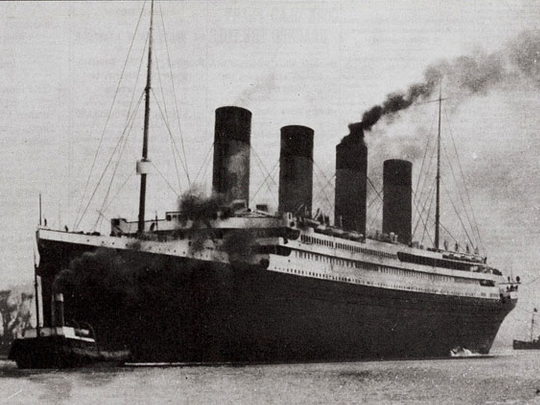
There's a scene in James Cameron's blockbuster movie, Titanic, where a flimsily-dressed Kate Winslet and Leonardo DiCaprio stand on the bow of the ill-fated ship, arms outstretched, and proclaim they're "king of the world".
In truth, if that had happened on the real ship during its tragic maiden voyage, they'd be frozen stiff from the wind chill — a combination of the 23 knots the ship was making that night a century ago and the biting Arctic chill coming down from the Davis Sea between Greenland and Canada's Labrador coast.
TITANIC DISASTER - GENUINE FOOTAGE
That was the same wind that brought an unusually high number of icebergs from their calving grounds off the west coast of the world's largest island — and it was one of those that dealt the decisive glancing gash to the White Star liner's hull.
The story of the ship and its sinking have captivated generations.
The sinking of the unsinkable ship on its maiden voyage, the tragic loss of more than 1,500 lives, the movies and the myths have had a deep impact on our psyche.
The city of Belfast, where the Titanic and her sister ships Britannic and Oceanic were built, has invested nearly £100 million to turn the legend into the ultimate tourism experience.
But it's also a chance for the city to tell of its history as the largest shipbuilding facility in the world in the heyday of transatlantic sailing.
If the British Empire was built on its ability to rule the waves, most of those ships were built in Belfast, where nearly 50,000 men worked in the yards of Harland and Wolff — the largest maritime construction facility in the world.
The Titanic had a date with destiny on the night of April 14, 1912, and some would argue that the ship was always unlucky.
A full year before its maiden voyage, the Titanic claimed its first victim. As the empty hull was launched down a slip on the city's RiverLagan, a shipwright was crushed, and died the next day.
That hull was later moved to a fitting out dock for completion. In another stroke of bad luck, the sea trials and maiden voyage of the fitted-out ship were delayed by two weeks when the fitting-out dock was needed to repair Titanic's slightly smaller sister, Oceanic, which was damaged in a collision at sea with a naval ship.
The Harland and Wolff shipyards are largely dormant now, a place where sailmakers, rope makers, shipwrights, boilermakers, riveters, steel pressers, painters and a host of long-lost tradesmen toiled building the might of the British Empire.
There were more than three million rivets pounded into the hull of the Titanic. Each was hammered in by hand, and each was a highly skilful and dangerous process where the rivet was heated to red hot, then physically tossed up scaffolding to where it was needed, caught by young boys in leather buckets, then held in place by an assistant before the riveter hammered it home.
Most working the rivets were deaf from the constant pounding inside steel hulls, and most riveters were without some of their fingers, regularly having them severed as the giant steel plates slipped during the construction process.
A multi-media visitor centre has been built to replicate the bows of the Titanic and its sister ships, standing 125 feet above the ground. Inside, the central staircase and first-class dining room have been recreated, and the floor of the exhibition is withdrawn, showing a replica of the wreck as she sits in two pieces at a depth over nearly 4,000 metres off the coast of Canada.
Unesco declared the wreck a world heritage site in a bid to protect it. So far, some 700 divers have descended on the wreck in which 124 first class, 166 second class, 530 third class and 692 crew died.













